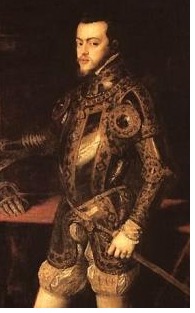Philip II
king of Spain and Portugal, supporter of the Counter-Reformation, b. 21 May 1527 (Valladolid, Spain), d. 13 September 1598 (El Escorial).
 Philip II was the son of the Holy Roman Emperor Charles V and Isabella of Portugal. Occasionally Charles V wrote secret memoranda for his young son, which outlined the duties of high office as a calling from God and warned against placing too much trust in advisers. Philip took the advice into his heart, and from the age of 16 Charles could appoint him regent of Spain during his absences from the country.
Philip II was the son of the Holy Roman Emperor Charles V and Isabella of Portugal. Occasionally Charles V wrote secret memoranda for his young son, which outlined the duties of high office as a calling from God and warned against placing too much trust in advisers. Philip took the advice into his heart, and from the age of 16 Charles could appoint him regent of Spain during his absences from the country.
At the age of 21 - 24 Philip visited Italy, Germany and the Netherlands. Most educated people, including royalty, could speak several European languages at the time, and Philip's inability to speak any language other than Castilian created negative comment wherever he went.
In 1540 Charles made Philip II Duke of Milan; in 1554 he made him king of Naples and Sicily. In 1555 Charles V stood down as ruler of the Netherlands and handed the country over to Philip; in the following year he resigned in favour of Philip, who now also was king of Spain and its overseas possessions (while the German countries - under the Habsburg dynasty - and the title of Holy Roman Emperor went to Philip's uncle Ferdinand I).
From his travels through the Netherlands, where a rising merchant class had developed political strength, Philip had experienced the public hopes for an end to feudal reign and to high taxes for needed to support the luxurious life of the old aristocracy, but he was determined to keep the old order. From 1559 he never left the Iberian peninsula and ruled his empire from a small office in his palace in Madrid through an elaborate system of paperwork ("consultas").
Opposition to the old feudal order went hand in hand with opposition to the Catholic church, which had not only aligned itself with the aristocracy but in many parts of Europe also exercised state power through its bishops and archbishops. The Netherlands and England in particular had adopted Protestantism. Philip thus became a staunch proponent of the Catholic Counter-Reformation.
For a brief period the Spanish Empire reached the height of its power under Philip's reign: It included Portugal, the Netherlands and much of Italy and had vast overseas colonial possessions. But the devastation and terror of the Spanish occupation, the introduction of new taxes and the execution of moderate Dutch aristocrats who attempted to negotiate with the Spanish occupation led to the uprising of the northern provinces of the Netherlands in 1566, and through the remainder of his reign Philip fought a loosing war.
In 1581 the northern provinces declared Philip deposed and established the future Dutch republic. (This is sometimes seen as the first bourgeois revolution in history.) Spain managed to keep control of the southern provinces, the future Belgium.
Philip's attempt to subdue England was equally disastrous. After a massive naval building programme he sent his Armada against the English navy of Elizabeth I; it was totally destroyed in 1588.
Philip's major military victory was in the south. He defeated the Ottoman navy in the Battle of Lepanto of 1571 and drove the Moorish population from Spain, ending the Arab influence in Europe. Since the Arab civilization had been the custodian of the scientific and philosophical achievements of ancient Greece and Rome and the economical motor of the Spanish Empire, this eviction led to economic and intellectual stagnation and established Spain as the centre of European reactionary forces well into the next century and decided its position during the Thirty Years' War. Feudal properties expanded through expropriation of the peasants, while rising taxes for the common people could not avert the bankruptcy of the state finances in 1557 and again in 1575.
Portrait: painting by Titian, 1550-1551, Museo del Prado, Madrid; public domain (Wikipedia)
home
 Philip II was the son of the Holy Roman Emperor Charles V and Isabella of Portugal. Occasionally Charles V wrote secret memoranda for his young son, which outlined the duties of high office as a calling from God and warned against placing too much trust in advisers. Philip took the advice into his heart, and from the age of 16 Charles could appoint him regent of Spain during his absences from the country.
Philip II was the son of the Holy Roman Emperor Charles V and Isabella of Portugal. Occasionally Charles V wrote secret memoranda for his young son, which outlined the duties of high office as a calling from God and warned against placing too much trust in advisers. Philip took the advice into his heart, and from the age of 16 Charles could appoint him regent of Spain during his absences from the country.